Day 2 of a 3 day long weekend of tours today. It was cloudy and increasingly blustery today, with winds gusting to 47mph this afternoon, so we spent the day dodging the showers. Still, it was surprising how much we saw despite the weather.
As we drove east along the coast road this morning, we flushed lots of Blackbirds and Chaffinches from the sides of the road. Our first destination was Blakeney, for a quick walk out around the Freshes before the wind picked up later. A couple of Brent Geese were feeding on the edge of the harbour channel just across from the car park but we could immediately see that one was much paler than the other. A closer look confirmed, one was a Pale-bellied Brent and the other a Dark-bellied Brent Goose.
 Pale-bellied and Dark-bellied Brent Geese – a nice comparison
Pale-bellied and Dark-bellied Brent Geese – a nice comparison
Dark-bellied is the regular form of Brent Goose which winters in large numbers here. This subspecies breeds in arctic Russia. Pale-bellied Brent Geese breed from Svalbard west across arctic Canada and winter mainly on the west coast of Scotland and in Ireland. We normally get a handful of Pale-bellied in with the flocks of Dark-bellied Brents here each winter and they occasionally form mixed pairs. Today was a great opportunity to see them side by side.
While we were watching the Brent Geese, we heard a Kingfisher call and looked across the channel to see two Kingfishers chasing each other low over the water. They flew over to our side of the channel and disappeared over the bank towards the Freshes. A little later we saw one of the zip back low across the reeds towards the wildfowl collection. A Marsh Harrier was quartering over the reeds a little further along.
Further along the seawall, as we got almost to the corner, we turned to look at the Freshes just in time to glimpse a dumpy bird dropping down into the grass on the edge of a flooded depression. We had a pretty good idea what it was, but we couldn’t see it from the seawall or from the path the other side. As we approached for a closer look, a Jack Snipe flew up and shot off towards the harbour – just what we had suspected. In flight, we could really see the small size and the shorter bill compared to a Common Snipe.
We continued on along the north side of the Freshes bank. There were lots of Skylarks down in the short weedy vegetation beyond the fence. A flock of Linnets flew in and dropped down there too briefly. A Rock Pipit flew over calling and landed on the fence, where we could get a good look at it through the scope. Reed Buntings occasionally flew up from the bushes but quickly disappeared back down again. A female Stonechat worked its way along the fence, dropping down onto the side of the bank periodically to look for food.
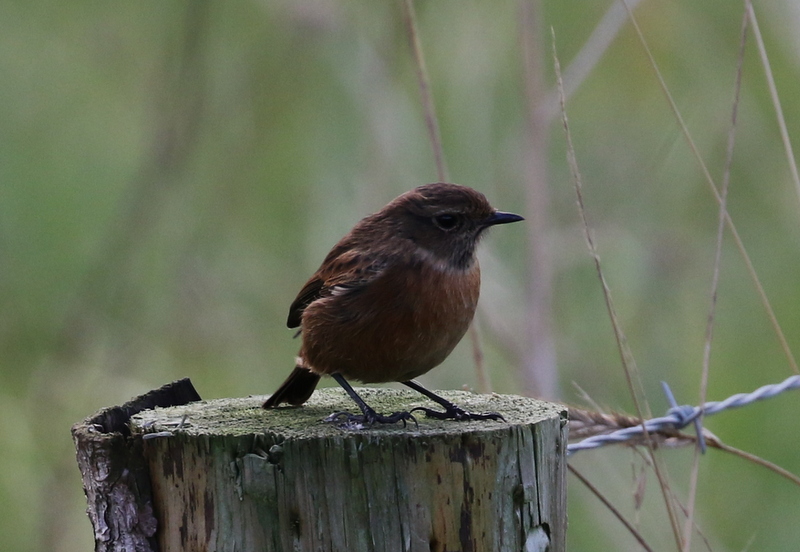 Stonechat – this lone female was working its way along the fence line
Stonechat – this lone female was working its way along the fence line
It is very exposed to the elements out on the seawall here. The wind was now starting to pick up and we could see dark clouds coming in towards us over the sea, so we decided to head back to the car. We had a quick look at the wildfowl in the Blakeney collection – none of which were allowed on the bird list for the day of course! We were just settled back in the warmth of the car when we saw two Peregrines over the edge of Friary Hills. A larger adult Peregrine, presumably a female, was chasing a smaller male juvenile – they swooped low over the grass before disappearing behind a hedge, coming out the other side and zooming off over the houses.
With the deterioration in the weather, we decided to head inland to get some respite. There have been some Waxwings in Holt for the last couple of days and as we turned into the road where they have most often been seen we could immediately see several photographers with long lenses pointed up into the trees. Even before we stopped, we could see Waxwings, and we could hear them calling as we got out of the car.
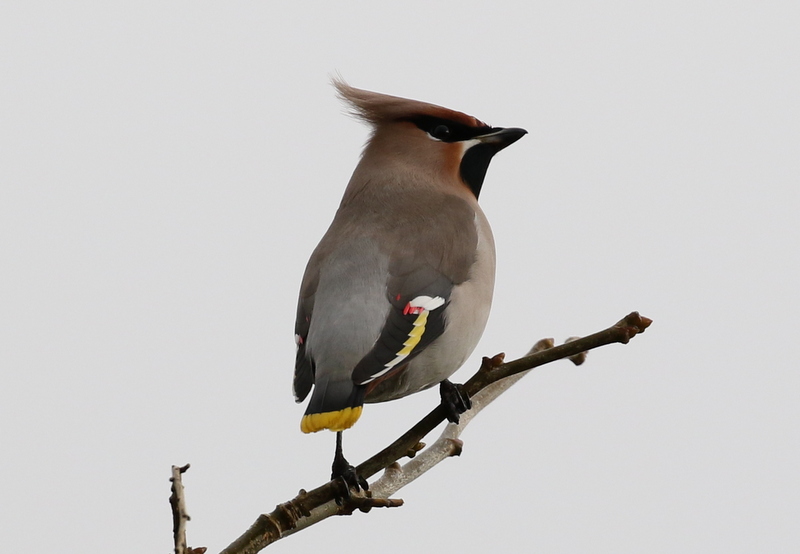 Waxwing – there were at least 20 in Holt today
Waxwing – there were at least 20 in Holt today
There were at least 20 Waxwings, but they were hard to count as they were feeding in several different trees, and frequently flying round in small groups or singles. The bulk of the group seemed to keep returning to the top of a large chestnut tree, where they were hard to see among the leaves. From there, they would drop down into several smaller rowans, where they would proceed to wolf down the red berries, much to the annoyance of the local Blackbirds! There was also an apple tree in one of the front gardens by the road, and several of the Waxwings kept coming down to attack the apples, clinging on to them and biting away at the flesh where they had been half eaten already.
 Waxwing – feeding on apples, as well as rowan berries
Waxwing – feeding on apples, as well as rowan berries
Having feasted ourselves, on such excellent views of such gorgeous looking birds, when the Waxwings flew off and disappeared round behind the buildings, we decided to move on. Our next stop was at Sheringham, where we went for a walk along the sea front.We thought we might pick up some seabirds on our way, but at first it seemed a little quiet, apart from hordes of Turnstones around the fishing boats which had been hauled up the slipway.
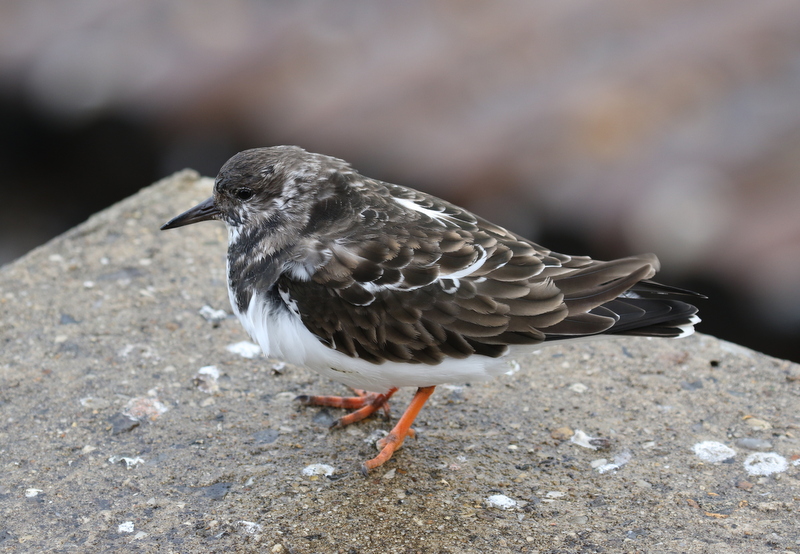 Turnstone – lots along the prom at Sheringham
Turnstone – lots along the prom at Sheringham
There was no sign of any Purple Sandpipers on their usual favourite rocks below the pub, but when we got to the shelter at the east end of the prom, we could see first one and then two Purple Sandpipers distantly out on the sea defences.
We stopped to talk to another couple of local birders who told us that the movement of seabirds was just picking up, after the wind had strengthened. A line of Common Scoter flew past with a single Tufted Duck in amongst them. A steady stream of Gannets tacked across the wind, heading east offshore, both white adults and dark grey-brown juveniles. There were little groups of Guillemots zooming across and a couple of Red-throated Divers went past too.Then a few Great Skuas started to pass by – in the half hour we stood there sheltering from the wind, we saw about ten – but they were all rather distant and hard to get everyone onto. A single juvenile Pomarine Skua was even further offshore.
As a particularly fierce squall blew in off the sea, we took shelter until it passed. Perhaps prompted by a Sanderling which came in with them, the two Purple Sandpipers took off and flew towards us, passing by and heading back to the rocks below the pub. We waited until the rain had stopped and decided to walk back to look for them. Unfortunately, by that stage they had disappeared again. We did find a couple of Ringed Plovers which had probably stopped off with the Turnstones to sit out the wind.
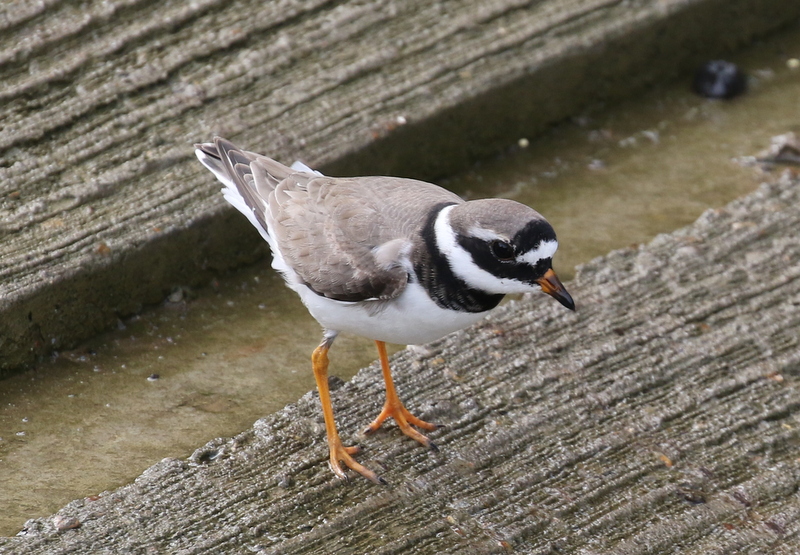 Ringed Plover – stopped off with the Turnstones on the slipway
Ringed Plover – stopped off with the Turnstones on the slipway
After lunch and a welcome hot drink back along the coast road at Cley, we drove round to Iron Road and headed down along Attenborough’s Way. There was a nice flock of Brent Geese out on the grazing meadows (all Dark-bellieds), and as well as the plain backed adults we could see quite a few stripe-backed juveniles. Hopefully, as the Brent Goose numbers increase over the coming weeks, it will prove to have been a good breeding season for them this year.
 Brent Geese – adults & juveniles on the grazing marshes
Brent Geese – adults & juveniles on the grazing marshes
Round at Babcock Hide, the wind was now whistling across the marshes. A little flock of Dunlin were feeding down at the front of the scrape below the hide, but they were very skittish and kept whirling round before dropping back down again. A pair of Redshank were defending their feeding territory in front of the hide, chasing off any others which tried to land there.
First one Black-tailed Godwit dropped in, then another five, stopping to feed for a few minutes before flying off again, flashing their boldly marked black and white wings. A couple of little groups of Lapwing flew in from the east and stopped to rest for a minute or two on the islands.
None of the waders would settle, in part because there were a couple of Marsh Harriers about. First, a dark juvenile flew across the reeds at the back of the pool, and drifted off towards Salthouse. Then a young male Marsh Harrier, with paler underwings and small patches of paler grey emerging on its upperwings, did the same. As they came over the grazing marshes, all the Wigeon shot out into the middle of the water from the banks. There were a few Teal and Mallard with them and three Shoveler appeared from behind the reeds too.
When a particularly dark cloud had passed over, we returned to the car and drove back round to the main part of the reserve. Just as we set out to walk to the hides, it started to rain so we hurried out along the boardwalk – thankfully it was only light rain and we got out there without getting wet.
There were several Shelduck out on Pat’s Pool and huddle of gulls out beyond the first island. A few Teal were out on one of the further islands, but there were not many waders – three Dunlin at the back and a couple of Black-tailed Godwits roosting in with the gulls. Simmond’s Scrape held more wildfowl – a larger flock of Wigeon, a good number of Teal and a huddle of around 20 Pintail asleep behind one of the islands. Presumably the waders had gone elsewhere in search of food and shelter. A Common Snipe was feeding on the bank outside Dauke’s Hide but flew across and landed down behind the grass in front of Teal Hide where we couldn’t see it.
A couple more Marsh Harriers quartered the reedbed beyond the scrapes this side. The light was starting to fade already and they were presumably gathering before going to roost. Several Pied Wagtails flew past while we watched, some of them dropping in to the islands briefly, before continuing on their way heading off to roost.
 Marsh Harrier – gathering over the reeds before going to roost
Marsh Harrier – gathering over the reeds before going to roost
Turning our attention to the gulls, we could immediately see a good selection of different species – Lesser and Great Black-backed Gulls, Herring Gulls and Black-headed Gulls. One of the herring gull-types looked different – it was very white-headed, whereas Herring Gulls typically have lots of grey blotches around the head at this time of year. Against the white head, the beady black eye really stood out – the nearby Herring Gulls instead showing a very pale iris. It was an adult Caspian Gull.
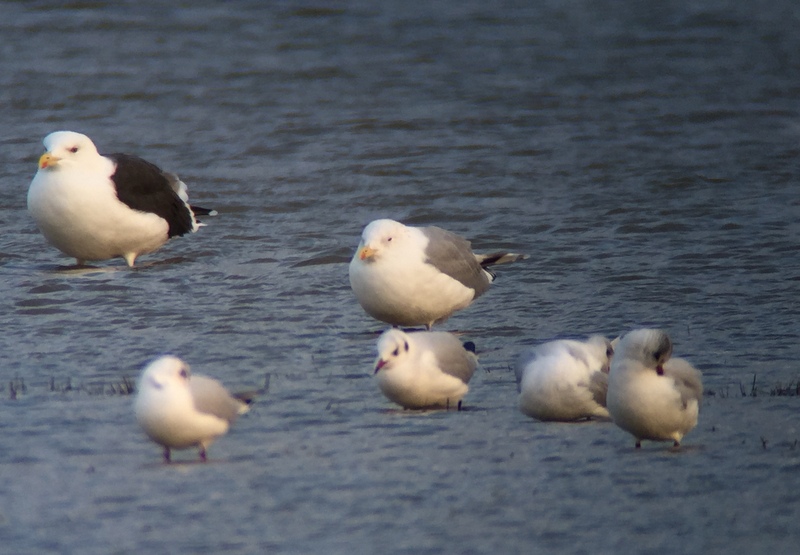 Caspian Gull – this adult was hunkered down against the wind on Pat’s Pool
Caspian Gull – this adult was hunkered down against the wind on Pat’s Pool
The Caspian Gull was hunkered down against the wind and didn’t initially look as long-billed and long-faced as they usually do. It kept returning to a little patch of cut rushes, behind which it tried to crouch down and shelter. However, the mantle was noticeably half a shade darker than the nearby Herring Gulls. Eventually, the Caspian Gull walked up onto the island and started preening, and now finally we could see the distinctive long head and bill.
Cley in the late evening is normally a good place to see different gulls gathering before they go to roost, but the Caspian Gulls often come in very late, just as it is getting dark, so we were lucky this one had arrived nice and early today. When some of the gulls flew across to Simmond’s Scrape, we turned to look there and found an adult Yellow-legged Gull to add to the day’s gull list. It was with a Lesser and a Great Black-backed Gull, giving a good comparison in mantle tone – it was noticeably much darker grey than the Herring Gulls but paler and less slatey than the Lesser Black-backeds.
At first, the Yellow-legged Gull was up to its belly in the water but eventually it climbed out onto the mud and we could finally see its deep yellow legs. The light was starting to fade now, and consequently they might not have appeared as bright to the unitiated as they otherwise would have done. It was time to call it a day, but it had been a nice way to end with such a good selection of gulls gathering.
















